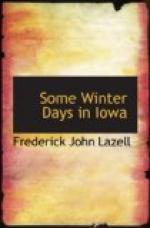Listen to the majestic roar of the winds in a grove of rugged oaks, and then again, for contrast, where the timber on the river bottom is all-yielding birch. It is like changing from the great diapason to the dulciana stop. In the mixed woodlands, so common in Iowa, the effect is even more delightful. The coarse, angular, unyielding twigs of the oaks give deep tones like the vibrations of the thick strings on the big double bass. The opposite, widespreading twigs of the ash sing like the cello, and the tones of the alternate spray of the lindens are finer, like the viola. The still smaller, opposite twigs of the maples murmur like the tender tones of the altos and the fine, yielding spray of the birches, the feathery elm and the hackberry make music pure and sweet as the wailing of the first violins. When the director of this maestoso March movement signals fortissimo the effect is sublime and the fine ear shall not fail to detect the overtones which come from the hop hornbeams and the hazel in the undergrowth below.
In keeping with the majestic orchestra is the continuous noise of grinding ice from the river. There is a sign at the edge of the birch swamp which says: “Positively no trespassing allowed here”—but it is not necessary now, for the river has overflowed the swamp and big masses of ice lean up against the trunks of the birches. Out in the main channel the river is swiftly flowing, packed with ice floes, from the little clear fragments which shine like crystals, to the great masses as big as the side of a house, bearing upon them the accumulated dust and dirt and uncleanness of the winter. Pieces of trees, trunks and roots, cornstalks from fields along the shore, all are being carried seaward. In the middle of the river the prow of a flat boat projects upward from between two huge ice floes which have mashed it, like a miniature wreck in arctic seas. The best view of this annual ice spectacle is to look up the river and see the big field of broken, tumbling, crashing, grinding ice coming down.
Farther down, at the narrows of the river, where the heavy timber shuts out the sunlight, the ice has not given way and here a gorge is formed. Hundreds of tons of ice are washed swiftly up to it and stop with a crash. The water backs up, flows over the banks and fills up all the summer fish ponds along the shore. Some of it forces its way through, foaming into a white spray. By-and-bye, under the combined influence of the rushing water and the ever increasing weight of the ice, the gorge gives way and the irresistible floes pass on with a mighty crash to their dissolution in the summery waters away down the Mississippi. After many months of shrouded death this new life of the river is also a symbol of the resurrection.
* * * * *
There are other days in March so soft and beautiful that they might well have a place in May.




